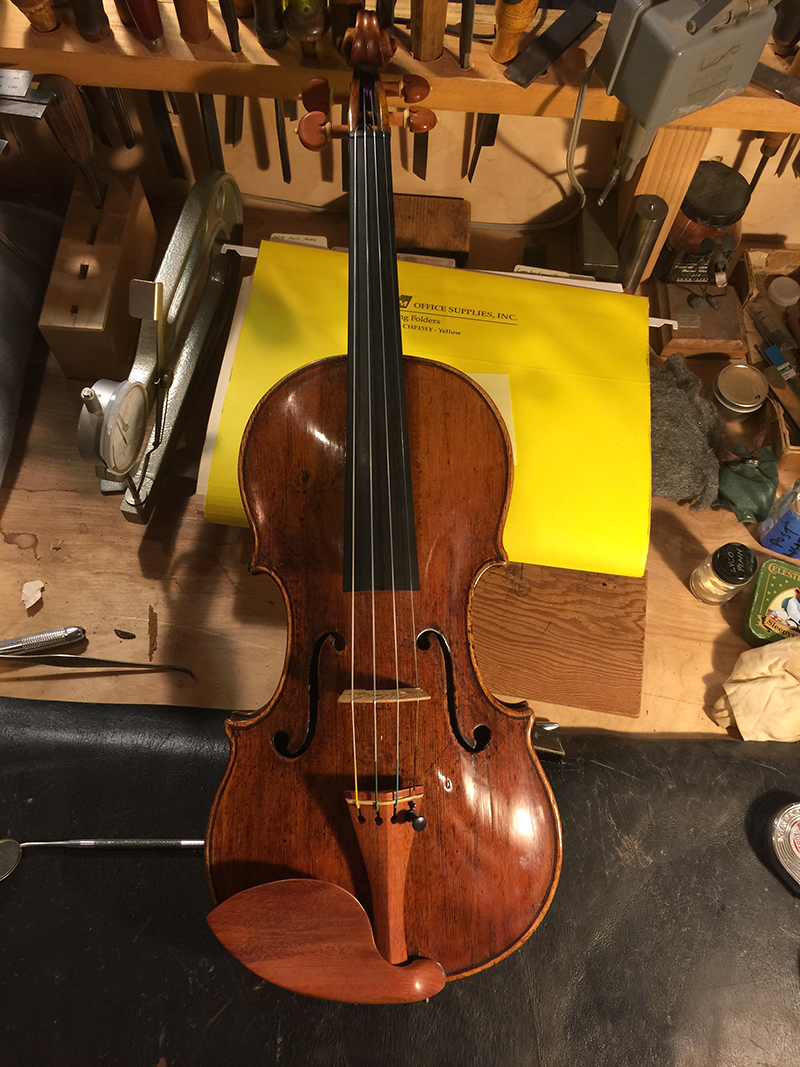A top-tier orchestra might well have tens of millions of dollars–worth of instruments on stage. Many of them are antiques. And there are few people who know these instruments more intimately than Paul Becker. He’s the fifth-generation owner and director of Chicago-based Carl Becker and Son, a 150-year-old luthier business. He and his family have restored the most famous instruments in the world, and they’ve put violins, violas, and cellos in the hands of many of the world’s finest musicians. In a wide-ranging conversation, Ben and Paul delve into all things stringed—from the the way the timbre of ancient violins compares to their modern counterparts (and competitors), the market for fakes, and the unique relationship between a musician and an instrument. Tune in for some great stories—and some great violin music, courtesy of special guest Katherine Lehman.
Benjamin Miller: Ok, I think that’s enough of that.
Welcome back to Curious Objects & the stories behind them. Brought to you by The Magazine ANTIQUES. I’m Ben Miller, and today’s curious object is one of the oldest violins in the world. Not the viola you just heard me, a total amateur, playing. But there is a connection, because both instruments actually passed through the hands of my guest for today’s interview.
There’s something I want to do before we get to him, though. On this program I’ve talked with people who have all kinds of fascinating old objects. But how many people can say they have a relationship with an antique that is as intimate as that of a musician and her instrument? I wanted to hear from a real live musician about what that relationship is like.
Benjamin Miller: Is your instrument more like a tool for you? Or is it more like a pet or a friend or a lover? How would you characterize it?
Katherine Lehman: Wow. I don’t want to anthropomorphize it. I don’t have a name for my violin; some people do, I don’t think of it that way. It’s less demanding than a pet, but it’s a deeply-beloved object.
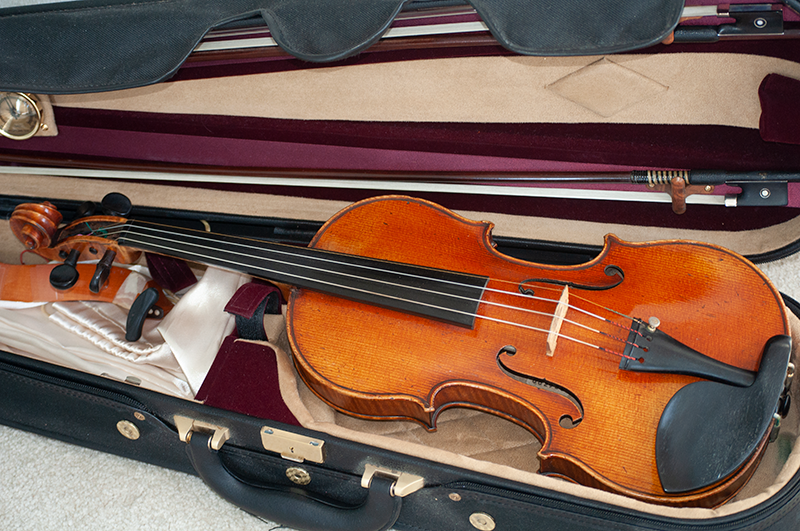
Violin by Jean-Baptiste Vuillaume, 1874. Katherine Lehman.
Benjamin Miller: I should introduce the violinist to you. That’s Katie Lehman, executive director of the Boulder Philharmonic. She also happens to be my mother.
Katherine Lehman: I could tell all sorts of great things about my son . . .
Benjamin Miller: That really won’t be necessary.
Benjamin Miller: Your instrument actually came from my guest for this episode, Paul Becker. What was it like to search for that instrument? How many violins did you try before you settled on this one?
“I thought the search for my new violin would take months or years, but in two weeks Paul called me and said, ‘this can’t wait; I have your violin.’”
Katherine Lehman: Well, it was actually a somewhat unusual search because I had just started to think about getting a much better instrument. Of course, that’s an extraordinary financial outlay so I hadn’t yet quite figured out how all of that was going to work. So I reached out to Paul and said “Paul, I’m looking for an instrument”—he knows my playing, he knows my personality, and he said “fine, I’ll keep an eye out.” And then literally—I don’t know whether it was a week or two later—he called me and said, “I have your violin.” Just exactly like that. And I said “but wait, Paul, I don’t have my financing in order, I’m just starting . . . this is supposed to be a many-months or possibly years process. What do you mean you have my violin?” He says, “this can’t wait; I have your violin.” And he’s not just, you know, being a salesman. He really . . . he knew.
Benjamin Miller: I wish there were a matchmaking service as effective as Paul.
Katherine Lehman: If there were he would be a multi-billionaire I’m sure by now.
Benjamin Miller: This is one of the ideas I really wanted to try and unpack in today’s episode. What does it really take to build that relationship between a person and—well, for branding sake, let’s call it a curious object?
Benjamin Miller: Do you think that there are personality traits that correspond to different qualities in a musician or in an instrument that’s right for a particular musician, and [that] someone who’s disposed to, you know, make a lot of jokes [is] likely to like an instrument that sounds a particular way? Or is it more subtle than that? Is there something deeper rooted?
Paul Becker: Wow. I would say that it’s very difficult to figure out a personality trait that matches a style—
Benjamin Miller: That’s Paul Becker of the Chicago firm Carl Becker and Son.
Paul Becker: —But the right instrument exposes the person’s inner emotions and it doesn’t always match their outer . . . what they put out there.
“It’s amazing how you hear the music across the hall or in a room and can just tell that someone really attached to something.”
Benjamin Miller: And if you think this all sounds pretty abstract—well, Paul at least thinks it makes a big difference.
Paul Becker: Oh, it’s amazing how you hear it across the hall or down the room. I can tell when someone really attaches to something.
[music plays]Katherine Lehman: I’ll just stop there; that will give you a little bit of a sample.
Benjamin Miller: Wow, well, thanks, mom.
Katherine Lehman: You’re welcome.
Benjamin Miller: A top-tier orchestra might well have tens of millions of dollars–worth of instruments on stage. Many of them are antiques. And there are few people who know these instruments more intimately than Paul Becker. He’s the fifth generation of a 150-year-old business. He and his family have restored the most expensive instruments in the world, and they’ve put violins, violas, and cellos in the hands of many of the world’s best musicians—not to mention my mother and me!
I wanted to learn what Paul was so excited about. So I took a little trip to the exotic land . . . of Chicago.
Benjamin Miller: First things first, I want to say a quick word about our sponsor, America’s oldest auction house, Freeman’s. Located in Center City, Philadelphia, Freeman’s has been telling the stories of valued objects and collections since 1805. On April 29, Freeman’s will bring to auction the collection of Dorrance “Dodo” H. Hamilton. The venerable philanthropist’s collection features fine European and American paintings—including works by Paul Cezanne, Daniel Garber, and John James Audubon—as well as furniture and decorative objects, and jewelry. For more information, please visit Freeman’s online at www.freemansauction.com.
Benjamin Miller: I went to Paul’s shop in the Fine Arts Building, one of Chicago’s great art nouveau icons. It’s a block from the Art Institute, and the building itself has some pretty interesting history behind it.
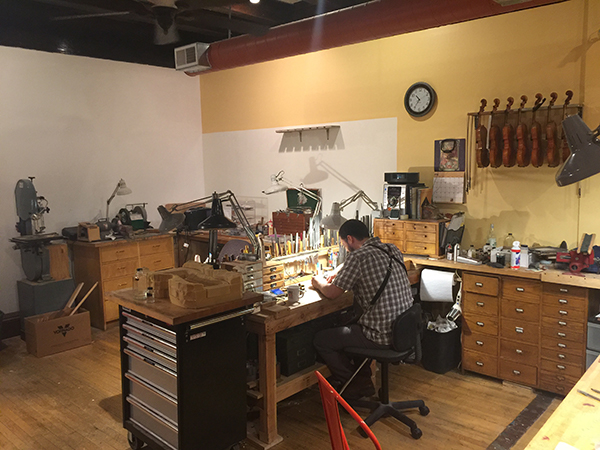
Photograph courtesy of Carl Becker and Son.
Paul Becker: This used to be a restaurant . . . they’ve been restoring all the brick work in here.
Benjamin Miller: It’s gorgeous.
Paul Becker: This was designed by Frank Lloyd Wright. He had to do the ceiling because he lost a bet. [laughter] It’s a cool building.
Benjamin Miller: It is very cool.
Sound check here. So just keep talking.
Paul Becker: Yeah, so Herman Macklett was the first of our family. He moved here from Germany and he started a music store up on Wabash Avenue in Chicago back in 1850-something. Old enough. [laughter] But in the 1850s he started a violin shop.
Benjamin Miller: Sometime before the Civil War.
Paul Becker: I took over from my dad who died in 2013. So I continue the business and continue making.
Benjamin Miller: It’s funny because I remember when . . . you know I have a viola from you. You had brought a number of instruments down to Tennessee where I was living and so I was able to try out a handful of different violas and bows. And I remember at a certain point you were I think talking with my mother—she was trying an instrument—and you had told me to play around, pick up whatever I wanted, play it. And so I was going through instruments one after another and then I picked up a viola and a bow and started playing and after about a quarter of a second I stopped and I started again and I stopped and I thought, “this is amazing” because the sound that it was producing was completely unlike anything that I had experienced. And so I started playing around on it a bit and after twenty or thirty seconds you came over and said, “what are you playing?” And then you took a look at it and you said “Oh. You can’t have that.” So it was a little above my budget. It was a little above my parents’ budget. But I still remember the experience of playing that. It was it was really amazing.
“Music affects your emotions, so you need to be open to create connections with the players and the instruments they’re playing.”
And I wanted to start out there actually because you have a very interesting violin here for us to talk about. But to kick things off I just wanted to try to get a better sense about the relationship between the musician and the instrument. Most of the people that I talk with for this podcast are buying and selling, or handling in some capacity or other, antique furniture, antique paintings, antique jewelry—pieces that, certainly, people might develop an attachment to but it maybe is not the same level of intimacy as the relationship between a violinist and a violin. That is a very special connection. And I want to dive into that and sort of see if I can better understand if—if my listeners can better understand—what that relationship really looks like. And so I just wanted to start out by asking, How do you . . . how you go about matching a musician with the right instrument? I mean there’s price, of course, but, aside from that, how do you find the right qualities and the right features for the right . . . for the right player?
Paul Becker: It’s very basic. It’s done by listening and by opening up how I feel. Because music affects your emotions. So you have to be open in your emotions to create connections with your . . . with the players that you’re working with and with the items that they’re using. So there’s a depth of knowledge for inventory to understand how each item works. Our business and our family has always tried to make each instrument play at its best, not play according to what we wanted to hear. So we have always worked . . . so I have this array of how instruments work and how fast they play, how quickly they respond to vibrato, how clean their sound is compared to how dirty their sound is, and then I listen to that player play an example of an instrument that I’ll start out with. And usually it will be an instrument we made, so I know the instrument very well. It will be a Becker.
Benjamin Miller: These qualities you’re talking about—the response to vibrato—are these, is that a sort of an implicit idea or is there . . . do you have charts? Do you have graphs? To what extent is that something you’re intuiting versus something that you’re really sort of grading or measuring.
Paul Becker: Well I like to say that the measurements are the blood for inspiration. So we do an intense amount of measurement but it is still an educated guess at the end. But the ones that are right made my heart swell. You can’t help but hear it instantly when someone has the right item. And everybody in the room will know instantly that it’s the right item. And it just plucks the right emotional strings and it creates a sound that everybody wants to listen to whether it be a scale or a phrase or a masterpiece that was written. It really doesn’t matter because there is a connection to the person’s soul that loves that exercise.
Benjamin Miller: Does it always work that way that when it clicks for the musician everyone can hear it?
Paul Becker: Yeah, it’s almost . . . it’s like we had . . . we have a Tecchler cello that is being purchased by a Mr. Lee who is buying it for the Detroit Symphony Orchestra for the principal cellist. We’re right in the middle of that, it’s just finishing off. But when the principal cellist came in he was looking for a cello that would sell for maybe three hundred to four hundred thousand dollars. This was his budget and he was looking at things and he already played on a Gulliano cello which is probably the same price but he wanted something that would project out in a principal position way. So we showed him what we had and then my salesman had played this wonderful David Tecchler cello that was made in 1700. And he said, “that’s the cello for this guy.” I said, “yes, but that cello sells for 1.35 million dollars. It’s a little bit out of his budget.” And my salesman—against my wishes—took that cello and showed it to him. It made me pretty angry because . . . how can this person quadruple his price?
Benjamin Miller: A little bit of a tease, isn’t it?
Paul Becker: Of course! But the cello was not a nice-sounding cello. The cello was a little . . . it’s a little “mean” is the way to put it; has a little edge to it and it’s . . . Hans Jansen said that it sounded like a monster.
“You can’t help but hear it instantly when someone has the right instrument. Everybody in the room will know instantly. There is a connection to the person’s soul.”
Benjamin Miller: A monster!
Paul Becker: And the player is one of the sweetest-personality people, the kindest in every respect that you can ever meet. The cello he played on was a very sweet-sounding voice. I would never have guessed that to be exactly right. But he showed it. He played it and I was up against myself saying, “What am I going to do about this?” And that was last October and now today we’ve gone through a cycle of letting him play an instrument . . . that instrument he played the Elgar for the orchestra. He practiced on that cello for two weeks and he got one of these performances that it just made everyone jump out of their seats.
Benjamin Miller: Playing the Elgar Cello Concerto?
Paul Becker: Yeah. And just in two weeks of practice the cello was his. It was . . . it was not pretty. He struggled to understand it, but that fight that took place created an emotional volcano that came out of the right place. I listened to this. I went to the first rehearsal because I was very concerned he was going to try and play this piece in two weeks and that’s just . . . no, no that’s too fast! And so I sat there to see if I needed to do an adjustment or something and he came out and it was their first rehearsal, they’re in their jeans and T-shirts and very loose and he started to play and the A string sounded a little bit weak, the C string didn’t, it sounded really big and powerful. And I met him during the break—we were supposed to go out to lunch—and he said “Well, I love the cello. It sounds fantastic on the A but the C sounds a little stiff.” And I said, “Well, that’s the opposite of what I heard.”
Benjamin Miller: That’s so funny.
Paul Becker: In the audience the A was very weak, and he said, “Well, because I’ve been holding back on the A because it’s so strong”. And I said “Well, I can hardly hear it and the C string was booming everywhere, it was filling the hall.” And that made him really concerned and he goes, “You know, I’ve been practicing in a practice room and in my house and this is the first time I’ve played it in the hall.” So he said, “I don’t want to go to lunch” and he decided to practice through lunch. Came back for the second half of the rehearsal. He started to play the A string and it was coming out stronger and stronger and stronger and the C string was just the same. But all of a sudden it felt like it was blowing my hair back. It just screamed out of that hall. And they played through the Elgar and the orchestra stood up and gave him a standing ovation in their T-shirts and jeans and the conductor was tapping his baton.
“All of a sudden it felt like it was blowing my hair back. It just screamed out of that hall.”
Benjamin Miller: That’s not a common thing for an orchestra.
Paul Becker: No, that’s not where you get your standing ovation is not during a first practice. I met him after that performance and he goes, “You know, that cello as I pushed on it and as I played this it just helped me. This cello helps me.” And he said, “It’s not my personality but it brings something out of me.” And everybody recognized it and so he had to have that cello. So the orchestra went through a fund-raising thing for their non-profit to try and buy this cello for him. We got the time from the owners to allow this to happen and finally a gentleman came through and was buying this cello for him. So in the end he’s ending up with this cello despite all the barriers that we ran into. And every time he gives a performance he’s getting these overwhelming responses for his play.
“’This cello helps me,’ he said. ‘It’s not my personality but it brings something out of me.’”
Benjamin Miller: Paul and his colleagues don’t just buy and sell instruments, they also make new ones. And they use some of the great instruments they’ve worked on over the years as models for their own creations.
Why don’t we take a little wander around? You can show me some of your tools, some of your setups and maybe I’ll snap a couple of pictures if you don’t mind.
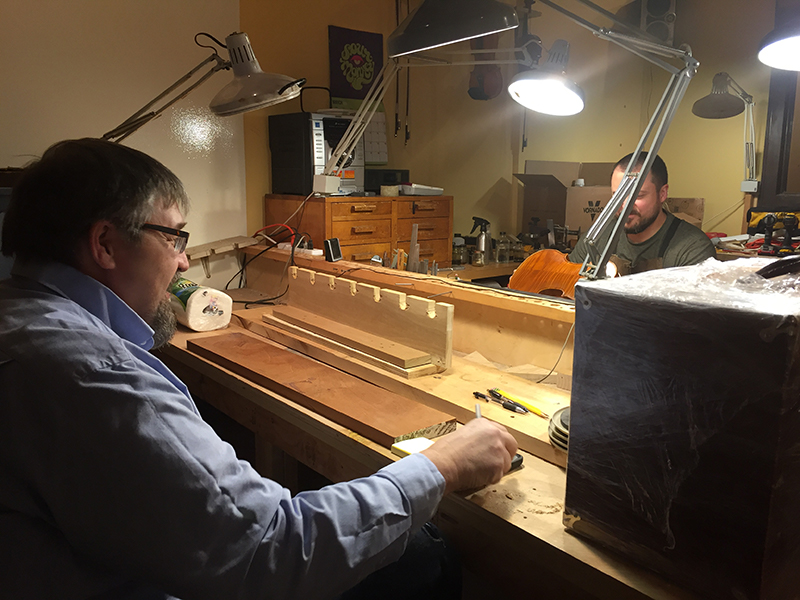
Photograph courtesy of Carl Becker and Son.
Paul Becker: No problem.
Benjamin Miller: So I’m just going to carry this around in case someone says something interesting.
I feel like I’ve just stepped into a safe deposit box in a bank.
Paul took me on a walk around his shop, which is full of instruments in various states of construction and restoration.
So you have it looks like a dozen or so cellos in here, probably fifty violins . . .
Paul Becker: More like about two hundred. And those are violas down there . . .
Benjamin Miller: Paul showed me some of the firm’s files, generations-worth of precise diagrams of incredibly rare and valuable instruments. There were blueprints showing the thickness of the wood of a violin at every point across its surface. They actually looked a lot like navigational maps, which makes sense when you consider that Pauls father was a pilot in World War II.
He also showed me their offsite workshop—that’s where they do the rough-cutting.
Paul Becker: Here’s our humble shop!
Benjamin Miller: I don’t know what I was expecting, but it’s a carpenter’s workshop!
Paul Becker: Well, I like making furniture also so I also have some of those tools.
Benjamin Miller: It’s mostly stringed instruments, of course, but, given Paul’s expertise with wood, maybe it shouldn’t come as a surprise to see him meddling with some very old furniture.
Henry the VIII. Wow. You don’t see too much furniture from the fifteenth century
Paul Becker: No.
Benjamin Miller: Is it true that some of the old violin makers were using wood that had been chopped many years before?
Paul Becker: Oh yeah, I’ve got some wood from 1480—comes out of an old church. We’re wood collectors, we go way back!
Benjamin Miller: Paul was moving things around the workshop while we talked, I was asking him about how different woods affect the instrument, and why very old woods are often sought after by luthiers.
I mean, what is physically happening to the wood over time, why is it useful to have old wood?
Paul Becker: It’s like . . . with the walnut, when they cut walnut these days they kiln dry it because they want to get it ready for the market quick. So, they steam it, and it does two things: It gets the sap out of the wood, quickly, but it also makes all the colors steam through so it turns into one color. Ok? So, walnut doesn’t really grow that way. Walnut looks a lot like rosewood, where you have white next to dark and you have streaks through it; there’re these purples and reds. And when you think about walnut you’re thinking of brown color, but that’s not truly walnut. Like if you look at that, that has those streaks like mahogany and the old-world walnut.
Paul has accumulated a collection of multiple tons of wood over the years—enough, he says, to make three thousand violins. Some of it is extremely old. But the way he works the wood is different from the old masters. Paul actually incorporates a computer-guided router to form the rough shape of each piece—
Paul Becker: This is what I machine a scroll to before I carve it. It just gets rid of some of the rough wood.
Benjamin Miller: But he still relies on his own hands for the more sensitive parts of the process.
Tell me about handcrafting vs. mass production.
Paul Becker: Well, mass production could work just fine if the person behind the design understands and you can bring it down to a very small window of what works. But still it’s never going to have that perfect refinement to get that last bit of human voice in it. Regardless to what you do . . . you can get it close, you can get it to respond well, you can get it to be stable if you use the right materials that are aged long enough and you can go a long way with modern technology—I mean you can make exact copies of things—but still, it’s not the same piece of wood and still not the same varnish. Little differences can make a huge amount of difference.
We are very, very good at measuring our instruments. Right now I’m working to tighter tolerance than Dad did and he used to work to half a tenth of a millimeter.
“Mass production could work just fine. . . . But it’s never going to have the perfect refinement that gets the last bit of human voice in it.”
Benjamin Miller: Half a tenth of a millimeter?
Paul Becker: Yeah, half of a tenth of a millimeter was his tolerance.
Benjamin Miller: That’s less than a fingernail.
Paul Becker: Oh, it’s less than a human hair.
Benjamin Miller: Less than a human hair? Wow.
Paul Becker: Grandpa used to use his fingers, but he didn’t even have a caliper to use . . . he’d use his fingers. But when we measure some of his older instruments he’s within one tenth of a millimeter in all his measurements.
Benjamin Miller: Really!
Paul Becker: He was incredibly accurate because of how sensitive his touch and his eye-hand coordination was. He was very, very good with his intu— . . . with the way it felt. So I was taught how to measure, how to feel, how to see, and how things sounded, as you were cutting on them as to what to do. So it’s . . . you have to use all of your senses to create a violin that works. .
Benjamin Miller: So you’re not afraid that robots are going to take your job.
Paul Becker: I’m not worried about that. People think because I use these machines to start off that mine can’t be as good in certain respects but that isn’t . . . that is not accurate. Without the intuition in the end they wouldn’t have the voice that they have and so they are still made entirely by hand. Automation will take you to a point but it will never finish the product.
“You have to use all of your senses to create a violin that works.”
Benjamin Miller: This is maybe an impossible question, but how many hours, start to finish, do you put into an instrument?
Paul Becker: When I was learning, it took me two hundred hours start to finish for a violin. Now that I’m much experienced, I get it done in about eighty.
Benjamin Miller: Oh, right! Ok! [laughter] That’s still quite a lot of time! You’re going to have to ramp it up if you want to hit Strad’s record.
Paul Becker: Oh, I know that.
“When I was learning, it took me two hundred hours, start to finish, to make a violin. Now that I’m much-experienced, I get it done in about eighty.”
Benjamin Miller: Let’s take a quick break. Coming up, we’ll hear about one of the great old instruments Paul has been restoring and how it’s different from modern violins. We’ll also talk a bit about the sensitive subject of fakes and forgeries, and my mom might even squeeze in another word. Stay with us!
Once again, I’d like to thank our sponsor for this episode, America’s oldest auction house, Freeman’s. Located in Center City, Philadelphia, Freeman’s has been telling the stories of valued objects and collections since 1805. With international experience and comprehensive knowledge of market conditions, the specialists at Freeman’s work closely with consignors and collectors to offer unparalleled assistance in the sale and purchase of fine art, furniture, decorative arts, jewelry, books, and more. On April 29th, Freeman’s will bring to auction the collection of Dorrance “Dodo” H. Hamilton. Upcoming auctions in May include Modern & Contemporary Art on May 8, Fine Jewelry on May 9, British & European Furniture & Decorative Arts on May 22, and, on May 23, a special sale entitled “Gentleman Collectors: The Lucas Family of Baltimore.” For more information, please visit Freeman’s online at www.freemansauction.com
I also really want to thank you, for listening, and for sending me your feedback. I’m always looking for new ideas and suggestions, so send me an email at podcast@themagazineantiques.com. And, at the risk of sounding like a broken record—subscribe! Rate us on iTunes! And tell your friends to listen! Let’s get these stories out there in the world!
Ok, let’s get back to Paul.
You have a very interesting violin here for us to talk about. This here is an Amati.
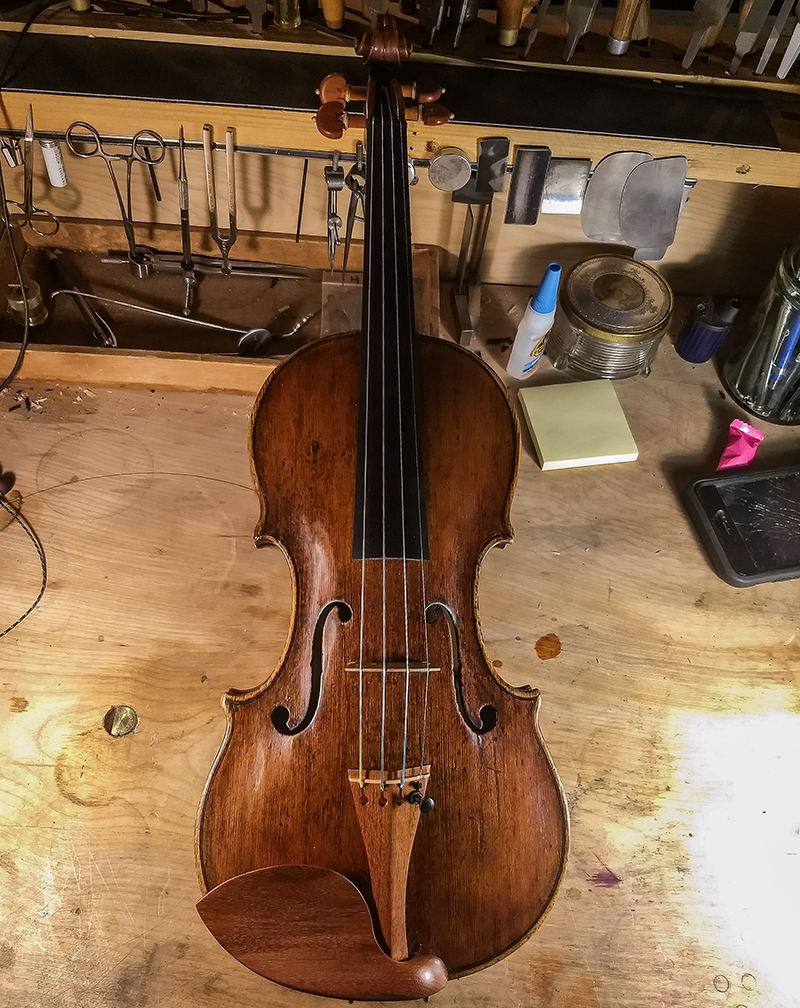
Violin by Antonio and Hieronymus Amati, 1620. Photographs courtesy of Carl Becker and Son.
Paul Becker: That’s right. It’s a violin that’s made in 1720. I’m sorry, 1620.
Benjamin Miller: 1620. Yeah, yeah.
Paul Becker: He was the son of Andre Amati, who was the grandfather of violins.
Benjamin Miller: Right, because the modern violin really was just coming into being around this time.
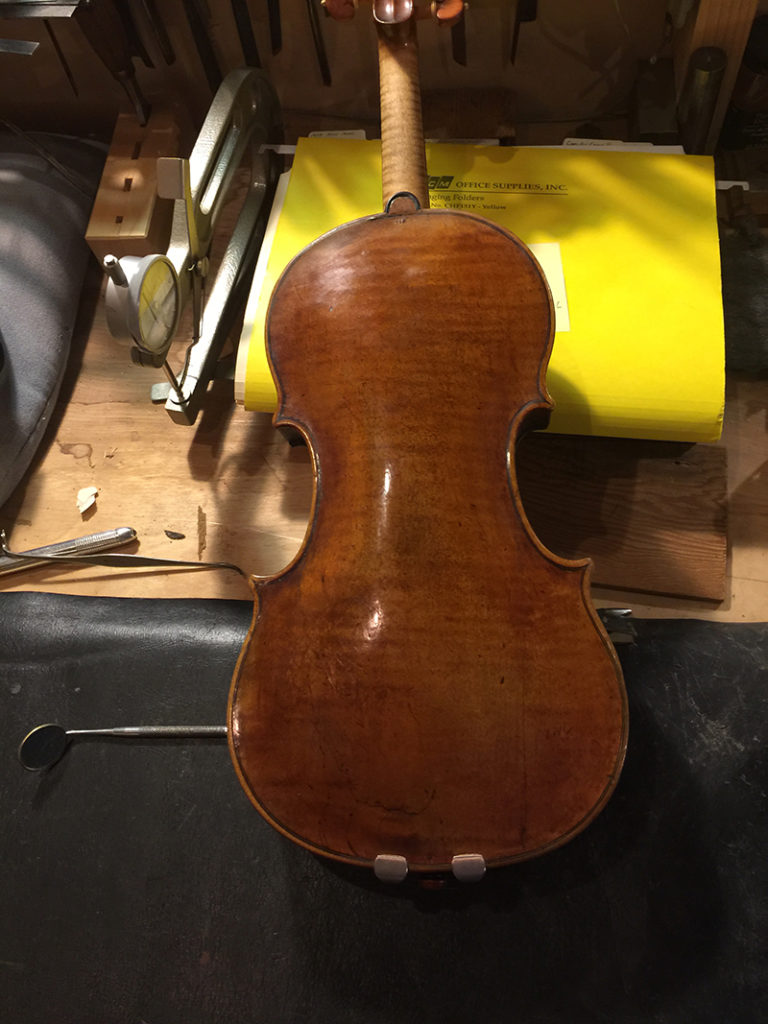
Violin by Antonio and Hieronymus Amati, 1620. Photograph courtesy of Carl Becker and Son.
Paul Becker: That’s right. So these are the earliest examples of the modern violin. This instrument is made by Antonio and Hieronymus which are the sons of Andre.
Benjamin Miller: And Andre is the one you’re referring to as the grandfather of the violin?
Paul Becker: Exactly. He worked in Brescia and was thought to work for Gasparo da Salò. He made the first violin-size instruments; before that he was making violas. Violas are actually before violins.
Benjamin Miller: When you say viola, are you talking about a viola da gamba or what kind of instrument are you describing?
Paul Becker: Well, yes. A lute was one . . . which our name comes from: luthiers.
Benjamin Miller: Ah, right. I never put that together.
Paul Becker: Yeah. So a lute is the predecessor to the viol, “viola,” if you will. And from there came the violin by Andre Amati and then came his two sons Antonio and Hieronymus who made these instruments. The one I hold in my hand is one that traveled to Russia and was played there for most of its life.
Benjamin Miller: Really?
Paul Becker: Yep, and it has a great deal of its originality . . . original in all its parts.
Benjamin Miller: Does that include the neck?
Paul Becker: The neck is replaced because it was a baroque style neck.
Benjamin Miller: Which are shorter . . .
Paul Becker: Yep . . . so they’re shorter and steeper angle. And, as a result, it had a different projection to its sound. And we call that a modern setup which is basically something that started in 1780 . . . [laughter] a modern violin.
Benjamin Miller: “Modern” being a relative term.
Paul Becker: So this was a baroque set up though. It had traveled to Russia and was involved, very interestingly, in a stage coach accident where it had run over the case and put a series of . . .
Benjamin Miller: A stagecoach ran over the violin case?
Paul Becker: A stagecoach ran over the violin case and broke the instrument into smithereens on the lower end. And so it went through a huge restoration job.
Benjamin Miller: What are we talking about here?
Paul Becker: I can show . . .
Benjamin Miller: Wow.
Paul Becker: . . . cracks ran across right here. And it has a series on the top that match the back. Otherwise it survived quite well, so it has this light track of cracks from a stagecoach.
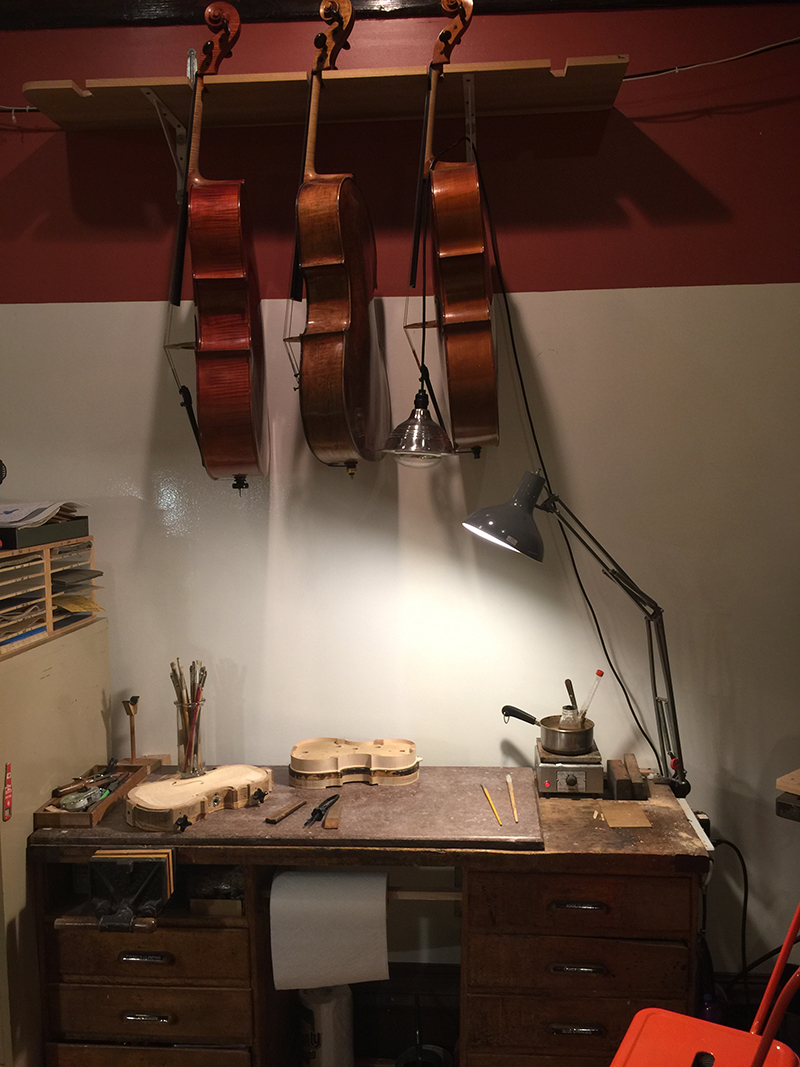
Cellos and violins in the shop. Photograph courtesy of Carl Becker and Son.
Ben Miller: You know, it’s funny, I mean, we sometimes have, you know, in the silver trade . . . of course, you see damaged pieces all the time that have been repaired and usually that detracts from the value, but sometimes if the damage has a story behind it—like the tankard that had a hole shot through it by a musket ball during the Revolutionary War—you know that actually can add value to the piece. I don’t know in this case if . . .
Paul Becker: It doesn’t add value but it does add a neat story. I don’t have any other instruments that were run over by a stagecoach.
Benjamin Miller: Really? This is the only one?
Paul Becker: This is the only one I know of. So it’s great, I love saying it, and the instrument’s gone through a tremendous restoration.
Benjamin Miller: And so the restoration was done skillfully, I assume.
Paul Becker: It was done in Russia.
Benjamin Miller: And how long ago was that done do you think?
Paul Becker: That was done, I believe, in the late 1800s.
Benjamin Miller: Oh right.
Paul Becker
Benjamin Miller: Yeah. Well, the whole thing is . . . I mean, I don’t look at enough violins on a daily basis to, you know, to be able to point to exactly what differentiates those. But it’s certainly an attractive and proportional piece and the color of it is spectacular.
Paul Becker: And that’s one thing . . .
Benjamin Miller: I mean it looks like an old piece of furniture or like a really excellent piece of seventeenth century furniture . . . the patina, the colors. It’s wonderful just as a visual object.
Paul Becker: Right, I mean it’s got a tremendous amount of original varnish and the finish has really survived.
Benjamin Miller: What does it sound like?
Paul Becker: It sounds fantastic. It has a full open voice . . . responds very quickly. Tonally, it’s . . . it deserves a great reputation.
Benjamin Miller: Do you have a bow around?
Paul Becker: . . . I’m not a player. So that’s not going to happen.
Benjamin Miller: That’s a shame!
So I need to cut in here and say that, sadly, we don’t get to hear the Amati being played today. I talked about that with Paul, and he made the point that without time for a professional violinist to grow accustomed to it, and a studio recording environment, it just wouldn’t sound its best. And I get it. Perfectionism is a pretty important part of the business—and that goes for a lot of dealers.
What are some some common misconceptions that people have about your business or your industry?
Paul Becker: That older is better. That’s not true. I’ve proven that over and over again. You do not have to play things in to get them to sound better. And I think that’s a big misconception. The modern instruments do take on a voice. The complexity is difficult to understand. Some of these old instruments, they’ve achieved that complexity. You can get that in modern instruments, but people don’t come in droves to see a Becker violin being played as a solo instrument. They will come in droves to see an Antonio Stradivari being played for people to witness. And it’s half the instrument and half the player in many instances that draw a crowd.
“A common misconception in the violin trade is that older is better. That’s not true. I’ve proven that over and over again.”
Benjamin Miller: And I wonder, I mean . . . should people be coming in droves to see a Becker?
Paul Becker: Absolutely. They sound terrific. They work. They fill a hall, they can create all these complexities in sound that you get from the old Italians because that’s who we learned from. My grandfather learned from restoring old fine instruments and there was an Amati cello that he restored and he made a cello alongside that Amati cello.
Benjamin Miller: A copy?
Paul Becker: A copy of that cello. That’s how he learned how to make his instruments. Someone from the Chicago Symphony came in and saw the cello that grandpa had made. He left and then had come back the next day and grandpa was actually delivering the real Amati to the member of the Chicago Symphony who was playing it. And he was playing it and he called out to that man that walked in and said, “Hey how does the cello sound?” And he goes “Oh it sounds fantastic but you can tell it’s new!” So that was a great, that was a great moment for my grandfather.
Benjamin Miller: This made it seem like it might not be too difficult to trick someone into thinking that a new instrument was actually an extremely valuable old one. I wanted to ask Paul about fakes and forgeries. This next part was recorded in the workshop, so the sound quality is a little rough. But Paul had some pretty interesting thoughts about the issue, so bear with me!
What kind of a market is there for fakes and forgeries in the instrument world? Are there a lot out there? Are they hard to identify?
Paul Becker: Well, some people . . . that’s how they make their living. Like Douglas Cox, from Vermont, he does it regularly. He copies instruments, puts that label in—a facsimile of the original label—along with his label: this is the violin he copied. He tries to match the wood, antique marks, everything. Would I ever get fooled by it? No. I mean, it just does not have the patina that you have in these old instruments. It’s fake and you know it.
Benjamin Miller: But someone else might get fooled by it.
Paul Becker: No. Not anyone who has any level of expertise. That’s not what it’s meant for. So they make copies, basically, for the modern musician, and it sells for $20,000 compared to $2 to $6 million. But they don’t sound the same, it’s not an exact copy.
Benjamin Miller: So you would say it would be more or less impossible to make a really convincing . . .
Paul Becker: No, it’s been done. Like Fent did it. He took a Strad cello and took the top off and made a new top for the ribs and back, then made a new back for the ribs and top, and made two Strads out of one. And it was convincing. He did it, he sold it.
Benjamin Miller: And how did it get discovered?
Paul Becker: ‘Cause both cellos got put together at the same time. And it got figured out [unintelligible] figured it out, actually. The Voller Brothers would copy instruments so well that that was their downfall, because they copied every imperfection in every instrument, when there is really only a number of imperfections in an instrument. And they just put it all in each instrument and that’s how they got figured out. There was a few others . . . those are the most famous. Those are the great ones.
When you realize that you have a German copy of a Guinary compared to a Guinary, that’s an $8 million mistake.
Benjamin Miller: I started out in this episode trying to understand the relationship between a musician and an instrument. But it’s becoming clear that the relationship isn’t really a duet—it’s a trio. The musician uses the instrument to create something wonderful. But the instrument itself is something wonderful on its own terms, a work of art created by the luthier. And, of course, there’s even another partner in this relationship: you and me, the audience. The ultimate craftsmanship of a person like Paul consists in his ability to tie it all together, from the wood and the measurements to the mood and the sound and the personality to bring about a moment of beauty and wonder.
Paul Becker: I think we have a unique business in this respect. Violins in their construction are considered art . . . sculpture work or artwork. However true art can’t be used, so it’s the only artwork that is usable that creates another art.
Benjamin Miller: Well, I would say [that] as a silver dealer I take exception to that because I would say that, you know, a lot of what we buy and sell is sort of in a similar category. And when we see a coffeepot, silver coffeepot in a museum it can be lovely and it’s nice that people get to see it but it can also feel like a bit of a shame that it’s never going to have coffee in it again.
Paul Becker: What I mean by what I’m saying is that you get a violin…construction is a beautiful piece of sculpture.
“Violins in their construction are considered art. However, it’s the only artwork that creates another art: music.”
Benjamin Miller: Sure.
Paul Becker: You could put it that way. Inside and out it has a function. Without a player and a luthier working together they can’t create the sound that turns into another art form. So a violin is then played to create another art form that you can only hear. You can’t keep. Even recordings don’t capture what happens in a performance. Which is the true art form.
Say you get a fine musician and you remember probably five great performances in your life that you’ve heard where people just jump up and applaud and they’re screaming out of their seats because it’s such a fantastic performance. And everybody will remember that for the rest of their lives. But if you think about that, that’s, you know . . . if you get to ten you’re amazing. If you get five performances in your lifetime of those kinds of things . . . think of a musician, how many times they’ve played those pieces and they get those reactions very few times in their life and they have studied their practice eight to ten hours a day. They have studied for sixteen years and they’ve tried to pursue playing gigs and all kinds of situations to get into the situation to play a performance and then only have one out of five hundred that create that. It’s an amazing amount of effort that goes into that one performance. To get that one that everybody remembers. There’s nothing else like it.
“Musicians have probably five great performances in their lives when people jump up and applaud and are just screaming because it’s such a fantastic performance.”
Benjamin Miller: Makes me think about an astronaut spending years of training to go around the earth a couple of times and come back down again.
Paul Becker: Exactly! Exactly! It’s a pursuit for the wellness of your soul.
[music plays]Katherine Lehman: It’s all the sensory experience of being with that instrument, it’s the vibration of holding it and playing it, the smell of the varnish and the wood, the beauty of it as a physical object. All of those things are just deeply meaningful to me.
Benjamin Miller: You’re getting poetic on me.
Katherine Lehman: Oh dear. It’s hard not to when you’re literally holding a work of art.
“It’s all the sensory experience of being with that instrument, it’s the vibration of holding it and playing it, the smell of the varnish and the wood, the beauty of it as a physical object.”
Ben: I think that’s a good note to close on, so to speak. Thanks, Mom.
I don’t know about you, but I feel like I’ve been on a real journey, and I don’t just mean to Chicago. I really hope you enjoyed being along for the ride! Again, you can email me at podcast@themagazineantiques.com.
Today’s episode was produced and edited by Sammy Dalati. Our music is by Trap Rabbit. And I’m your host, Ben Miller.
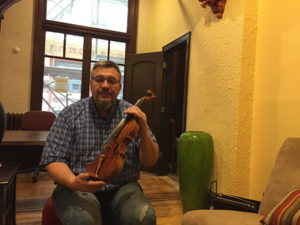
Photograph courtesy of Carl Becker and Son.
Paul C. Becker joined his father Carl F. and grandfather Carl G. at the bench when he was fourteen, working with his grandfather to complete his first violin. Paul briefly left Carl Becker and Son to begin his own woodworking company specializing in custom furniture, but decided his heart was in violin making and returned to the family business where he’s been ever since.

